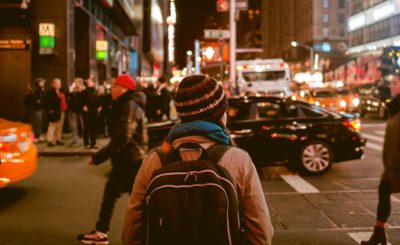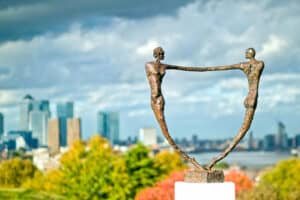
I grew up in a small Texas town with a population of around three thousand people. It has one stoplight. Traffic jams only happen if someone is driving their tractor down Main Street. It’s the kind of place all those country songs are talking about. And I loved growing up there. That small town fed me, and taught me how to love well in times of crises and celebrate in times of joy.
But the first time I went to New York City, I was mesmerized. I may have grown up a country girl, but God placed a love for the city deep down in my soul. The culture, the diversity—and goodness, the amazing variety of food! Since my first foray to the Big Apple back in 2007, I have been blessed to spend four of the past five years living in a city.
People don’t seem to think about “finding God” in the city. I don’t know anyone who goes on a spiritual retreat to downtown Atlanta, for example. Usually, when we want to connect with God, we take to nature: Luscious greenery, flowing rivers, and imposing mountains are prime locations for us to “find God.” Cities, on the other hand, often invoke thoughts of unruly crowds, traffic, unidentifiable smells, traffic, impoverished neighborhoods, and oh yes, traffic. Why would God be there?
People don’t seem to think about “finding God” in the city.
In 2014, 54% of the world’s population lived in urban areas. This number is only expected to grow in the coming years. Cities are also places of ethnic and cultural diversity, and three of the most diverse cities in the world are located in America. I can still remember the rush I felt on the New York subway when I first overheard conversations happening in multiple languages. Years later, I would read this observation taken from Marcy Heidish’s book Soul and the City: Finding God in the Noise and Frenzy of Life and I could do nothing but wholeheartedly agree:
In a city, perhaps more than in any other locale, we have God’s face all around us, if we look for it—not in the sky, but in the face of others…cities can show us how varied we are as human beings: varied in ethnicity, race, age, style, and health. We might think the cityscape hides god, but in a unique way, a metropolis reveals God’s presence through the diversity of His children, for all are created in God’s image.
Living in the city, I have made a concerted effort to align my spiritual disciplines with the routines and flow of life around me. When I am taking public transit, I am intentional about observing the diversity of people surrounding me, and reminding myself, “This person is made in God’s image.” Often, this thought turns into a prayer, for a stranger to whom I will likely never speak. It’s a hope that in some way throughout their day, they will know they are made in the image of the Creator.
Another spiritual practice I like to incorporate into my city life is reminding myself that we have a God who walks at three miles per hour. This clever and easy-to-remember dictum was first made popular by Koasuke Koyama’s book Three Mile an Hour God: Biblical Reflections, and illustrates how our God slows down to move at the same pace as the average human. Often, when I am out running my errands, I encounter the inevitable crowds. Nothing, and I mean nothing, enrages me more than when I have my grocery shopping perfectly planned, list in hand, the most effective path through the aisles prearranged—and the slowest shopper in the world steps in front of me, walking like they are out for a Sunday stroll. I try, although I don’t always succeed, to remind myself that we have a God who walks at three miles per hour. I remind myself that God daily slows down to walk with me, so I can surely get over the small inconvenience of having to walk at someone else’s pace in the grocery store. And when I think of it this way, it no longer feels like an inconvenience, but a privilege.
I try, although I don’t always succeed, to remind myself that we have a God who walks at three miles per hour.
The needs of the city and those living in them are often overwhelming. Homelessness, crime stemming from systemic poverty, pollution…the list could go on and on. The fragility of humanity is often painfully present. However, if Jesus is truly the stranger, the hungry, the naked, then Jesus is on every corner of the city.
In the city, as Heidish writes, the cry of the ambulance is a call to prayer, and strangers waiting for the bus create a shared experience of peace in the waiting. Church steeples and skyscrapers draw our gaze heavenwards. Why would God be in the city? Because the city is where God’s people dwell. And there are opportunities to love God and love neighbor at every turn.
Lyndsay Mathews is a graduate of Fuller Theological Seminary, where she received a M.A. in Intercultural Studies with an emphasis in at-risk children. After graduating in 2015, she spent a year working alongside the incredible staff at Abide Family Center located in Jinja, Uganda. Abide works to keep children in their families and out of orphanages. Currently, she writes for various organizations about the importance of family preservation in developing countries.



2 Responses
Thanks for writing this article I too hail from a small town but find enjoyment in places like New York City, and there is importance in seeing the face of God in different faces throughout the city!!!
Thanks for sharing this beautiful blog, and your amazing thoughts. It’s a pleasure to read this post. Keep sharing.